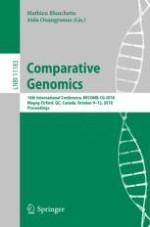2018 | Buch
Comparative Genomics
16th International Conference, RECOMB-CG 2018, Magog-Orford, QC, Canada, October 9-12, 2018, Proceedings
herausgegeben von: Prof. Mathieu Blanchette, Aïda Ouangraoua
Verlag: Springer International Publishing
Buchreihe : Lecture Notes in Computer Science
